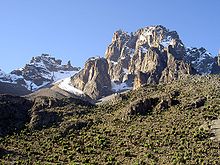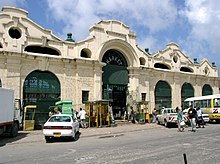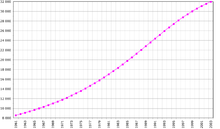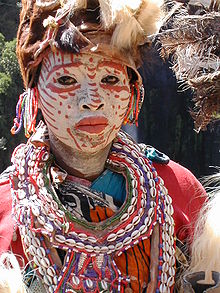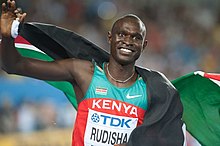Kenya
Kenya, officially the Republic of Kenya (Swahili: Jamhuri ya Kenya; English: Republic of Kenya), is a country in East Africa, bordered by Ethiopia to the north, Somalia to the east, Tanzania to the south, Uganda to the west and South Sudan to the northwest, with the Indian Ocean washing its coast southeast. Lake Victoria is located to the southwest and is shared with Uganda and Tanzania. Its capital is Nairobi. The country extends over an area of 580,367 km² and has a population of 46 million, with people of many cultures and origins. The name of the country is due to Mount Kenya, a traditional place in the country and the second highest mountain in Africa. Kenya is also known for its biodiversity.
The country has 47 districts, each governed semi-autonomously from the central government in Nairobi. Geographically, Kenya is divided into several areas with highly variable demographics, including savannah, arid and semi-arid areas, as well as a large coastline with the Indian Ocean. The central and western regions have forests and mountains, while the northern regions are more arid. As part of East Africa, Kenya has been home to man since the Lower Paleolithic. Bantu expansion reached the area in the 1st millennium BC, and the boundaries of the modern state comprise the passes of the Nilo-Saharan, Afro-Asiatic and Bantu linguistic and cultural areas, thus Kenya has been a multi-ethnic country since its origins. The European and Arab presence in Mombasa dates back to the early modern period, but exploration of the interior began in the 19th century. The British Empire established the East Africa Protectorate in 1895, known as the Colony of Kenya since 1920. The Independent Republic of Kenya was established in 1963.
The capital of Kenya, Nairobi, is a city of great commercial importance in Africa. The Kenyan economy is also the one with the highest gross domestic product in the East and Central Africa region. The country has been a traditional producer of tea and coffee, and more recently has been dedicated to the export of cut flowers to Europe. More and more Kenya is turning to the telecommunication industry. Kenya is also a world power in the sport, producing top athletes like champion Paul Tergat and more recently David Rudisha.
Etymology
The country takes its name from Mount Kenya, the highest peak in the country. The name means "luminous mountain" in one of the local languages. The original place-name in Swahili is Kenya, a term that is used at the state level in all foreign languages, as is the case with the Spanish texts of some international organizations, such as the United Nations. However, the prescribed place name for the Spanish language is the form adapted to the Spanish orthography, "Kenia".
In Swahili the digraph ny has the value of the letter ñ in Spanish. The Espasa Encyclopedia, in its 1961-1962 supplement, pages 800 to 802, used the form Keña (gentile keñano), more in line with the pronunciation used by Kenyans. His deformation to "Kenya" It probably comes from the English writing, Kenya, the same one that is used in dictionaries to facilitate the pronunciation of the ñ. These forms have not had continuity of use in modern Spanish due to the scarce communication between the people of East Africa with the great Spanish-speaking currents.
The majority and recommended demonym is Kenyan; however, the kenyatan form is also used.
History
Some fossils found in eastern Africa suggest that protohumans roamed the area of present-day Kenya more than twenty million years ago. Recent finds in the vicinity of Lake Turkana indicate that hominids such as Homo habilis and Homo erectus inhabited the territory more than 2.6 million years ago.
Colonial period
Portuguese
The Swahili developed Mombasa into a major port city and established trade links with other nearby city-states, as well as trading centers in Persia, Arabia and even India. In the 15th century, the Portuguese traveler Duarte Barbosa stated that "Mombasa is a place of heavy traffic and has a good port in which there are always moored small boats of many kinds and also large ships, both bound for Sofala and others that come from Cambay and Melinde and others that sail to the island of Zanzibar ".
Portugal's presence for two centuries was guaranteed by obtaining naval bases by force and by alliance agreements with local lords who had to pay taxes or trade exclusively with the Portuguese. These Territories became vassals of the king of Portugal, but maintained their degree of autonomy by maintaining their own king. It was only later that settlers began to arrive and eventually mixed with the locals. The alliances with the local leaders allowed, on the one hand, to guarantee the security of a territory, as well as the fluidity of the trade that was of interest. But not all tribes were always friendly, as seen in 1589, 1610, 1612 where some rebellions forced the Portuguese to fight with the help of other tribal alliances. This was the case of the so-called Zimba cannibal tribe that attacked the Portuguese in Malindi but was defeated in the south with the help of troops from the Mosseguejos tribe. The alliances were, however, very volatile, to the south in Mombasa the city was attacked by the Mussungualos in 1610, the same ones who would ally with the Portuguese in the Omanite siege of 1696.
Later, in 1698, and in 1730, the Swahili coast was definitively conquered from the Portuguese and came under the direct rule of the Omani Arabs, who expanded the slave trade to meet the demands of plantations in Oman and Zanzibar. Initially these traders came mainly from Oman, but later many came from Zanzibar (such as Tippu Tip).
Throughout the centuries, the Kenyan coast has played host to many traders and explorers. Among the cities that border the Kenyan coast is the city of Malindi. It has been a major Swahili settlement since the 14th century century and once rivaled Mombasa for dominance in the African Greater lakes. Malindi has traditionally been a port city friendly to foreign powers. The Malindi authorities also welcomed the Portuguese explorer Vasco da Gama in 1497.
19th century
Only in the late 19th century does Kenya's colonial history begin with the establishment of a German protectorate over the possessions sultan of Zanzibar in 1885, followed by the arrival of the British East Africa Company in 1888. The fledgling imperial rivalry ended when Germany conceded its coastal possessions to Britain in 1890, on the condition that Britain respected its dominance over its recently acquired possessions in present-day Tanzania.
Modeled in South Africa, in 1915 the British colonial administration made it compulsory for all blacks over the age of fifteen to wear a permanent certificate around their necks proving their identity and use. In 1920, the governor raised the per capita tax to force the Kikuyu to join the settlers as farm laborers in order to pay. However, when in 1921 the settlers reduced the wages of indigenous workers by a third, demonstrations and strikes broke out. On March 16, 57 protesters were shot dead and the leaders of the nationalist associations were arrested and deported.
From October 1952 to December 1959, Kenya was in a latent state of emergency as a result of the rebellion against British rule. The war left 100,000 dead and 320,000 prisoners (civilians and rebels) In 2011, after decades of waiting, thousands of secret documents from the British Foreign Office were declassified. They show that the rebels were systematically tortured and subjected to the most brutal practices, the men were castrated and sand was introduced into their anuses, the women were raped. Foreign Office records further reveal that it was not an initiative of soldiers or colonial administrators, but rather a policy orchestrated from London.
The first direct elections of Africans to the Legislative Council were held in 1957. Despite British hopes of handing command of the nation to a group of 'moderate' African leaders, it was the Jomo Kenyatta's Kenya African National Union (KANU) the political force that formed the first post-independence government of Kenya on December 12, 1963. Kenyatta became the country's top leader initially as prime minister and, from 1964, when Kenya became a republic, as the first president of the Republic.
Independence
Kenyatta introduces one-party rule. The president practiced an authoritarian and patronage policy to ensure national unity. However, according to the British historian John Lonsdale, Kenyatta perpetuates the colonial heritage that "institutes a state and not a nation." His power rests on "an ethnic feudalism [...] with its unequal contract of vassalage"
Kenya became a republic on December 12, 1963, with Kenyatta as its first president. He sought to maintain cordial relations with neighboring countries although this was difficult at times, especially with the Idi Amin Dada regime in Uganda. In 1967 the East African Community was created, an economic union of the three countries, considered as a first step towards political unification; this intention progressively disappeared, although at the beginning of the eighties the members of the old community considered its reinstatement.
The moderate and stable policy of the Kenyatta government attracted a large number of foreign investors; a new industrial area was established near Thika, and central Nairobi was modernized. The tourism industry, based on the large national wildlife reserves, expanded rapidly to become the most important source of foreign exchange earnings. Kenyatta was recognized at the time of his death in 1978 as Mzee, (the old warlock), not only by his own people but by a wide range of world leaders.
Fears of a possible civil war between the Luo and Kikuyu groups after Kenyatta's death proved unfounded and his successor, Daniel Arap Moi, a member of the Kalenjin tribe, initially maintained his predecessor's political and economic restraint. However, in June 1982, he officially made Kenya a one-party state. Two months later, loyalist troops crushed a coup attempt by 1,000 air force members and university students.
As the 1980s progressed, the government faced a growing stream of criticism from within and without the country. Many of Moi's critical leaders were jailed. At the end of 1991 the main international financial institutions and several Western governments suspended their economic aid, as a way of forcing the Moi government to carry out political and economic reforms.
Opposition parties were later legalized and Kenya's first multi-party elections were held on December 26, 1992. Moi and the Kanu were re-elected with a comfortable majority. However, the election (in which all parties capitalized on tribal allegiances) sparked a torrent of ethnic violence, mainly directed against the ruling Kikuyu, with tens of thousands of people displaced from their homes and hundreds killed halfway through. the decade.
At the same time, the government continued to harass opposition groups and harsh economic reforms were introduced at the insistence of international financial organizations aimed at fighting corruption, but they led to skyrocketing inflation, rising unemployment and severe restrictions on public services.
Kenya Today
In August 1997 serious ethnic conflicts broke out again in the country, and in November President Moi dissolved Parliament as a step prior to holding elections a month later, the date on which his five-year term ended, after two decades in power.
In September of that year, the president had agreed with some sectors of the opposition, after the marches and demonstrations demanding a greater democratization of the country, certain constitutional reforms through which several provisions from the colonial era that prohibited participation were repealed electoral opposition groups. These groups presented themselves divided to the elections, for which Moi was re-elected president in December.
The presidential and legislative elections held on December 27, 2002 marked the end of the hegemony of Moi and his party. In the presidential elections, Emilio Mwai Kibaki, presented by the opposition National Rainbow Coalition (Narc), obtained 62.3% of the votes and prevailed over the Kamu candidate, Uhuru Kenyatta, son of the country's first president, who won the 31.3%. In addition, the Narc would have an absolute majority in the new National Assembly thanks to its 132 deputies. Three days later, Kibaki officially succeeded Moi as president. Kibaki's period in power has been marred by corruption scandals and violent clashes due to the draft new constitution promoted by President Kibaki, which was rejected. in a referendum on November 21, 2005. This rejection of the project for a new constitution that would have granted broad powers to the president, has been seen as a vote of punishment for Kibaki himself and the opposition has demanded the calling of early elections.
In a referendum held on November 21, 2005, citizens rejected the draft of a new Constitution that had been the cause of serious confrontations even within the government itself. Two days later, the president, who had supported the constitutional project (while reinforcing the powers of the head of state), dissolved the government, several of whose members had opposed the approval of this new Magna Carta.
In the elections held on December 27, 2007, Kibaki was re-elected by obtaining 47% of the votes, Raila Odinga 44% and Kalonzo Musyoka 9%. Kibaki's victory, peppered with accusations of fraud, generated serious riots and clashes between groups related to the president (mainly linked to the Kikuyu ethnic group) and opponents of the ruling party (belonging, like Odinga, to the Luo ethnic group).
The crisis (which had unleashed a real tragedy: approximately 1,500 people dead and almost half a million displaced) only seemed to come to an end after, in February 2008, Kibaki and Odinga reached an agreement to establish a government of coalition in which the post of prime minister (abolished since 1964) would go to the leader of the party with the largest parliamentary representation, in this case, Odinga's Orange Democratic Movement, which became chief of cabinet the following April.
Starting in 2012, the actions of Islamist militias in the north increased, in whose actions they were supported from Somalia, among others by the Al-Shabbaab militia. The most serious incident was the bloody assault on the Westgate shopping center as it affected the capital Nairobi. During 2014 the attacks increased, increasing the number of victims. The maximum jihadist attack, at the University of Garissa, occurred on April 2, 2015, leaving 147 people dead, including the four terrorists who intervened (jihadist attack in Garissa University). On October 26, 2016, there was a terrorist attack perpetrated by the terrorist group Al-Shabbaab against a hotel near the border with Somalia through a car bomb explosion.
Government and politics
Since the 1991 constitution, the country has been governed by a system of multi-party democracy. Despite this, the former single party, the Kenya African National Union (KANU), remained the majority party under the leadership of Daniel Arap Moi until the 2002 presidential election., in which a broad coalition of opposition forces, under the leadership of Mwai Kibaki, defeated KANU. The government of President Kibaki promised the drafting of a new constitution that would limit the powers of the president. The debate on the new constitution triggered tensions between the members of the coalition, and violent riots in the country between 2004 and 2005. The final draft of the new constitution was rejected in a referendum on November 21, 2005. This result has led to the political opposition to demand the resignation of President Kibaki and to demand the calling of early elections.
Incidents after the 2007 elections
The last general election was held on December 27, 2007. President Kibaki of the National Unity Party was running for re-election against the main opposition party, the Orange Democratic Movement, which had Raila Odinga as its candidate.. At the beginning of the count it seemed that Odinga had a small but sufficient advantage. However, as the count ended, Kibaki managed to reduce the lead and ultimately prevail in the elections. Accusations of election fraud (endorsed by European observers) led to street protests and Odinga went so far as to proclaim himself the "President of the People," while calling for a recount and the resignation of Mwai Kibaki..
On June 18, Odinga called for an end to the demonstrations, while calling for an economic boycott of companies close to President Kibaki and calling for a strike. Kenya's finance minister estimated that the outbreak of violence has cost Kenya $1 billion.
After the August 2022 elections, the president is William Ruto.
Human Rights
In terms of human rights, regarding membership of the seven bodies of the International Bill of Human Rights, which include the Human Rights Committee (HRC), Kenya has signed or ratified:
Political-administrative organization
Since 2013, Kenya has been divided into 47 counties, each of which is headed by a governor. They are the first order divisions of Kenya. Previously, the country was organized into eight provinces.
The smallest administrative division corresponds to localities, which usually coincide with electoral districts. The localities take their name from a central population. Larger towns have several locations. Each town has a chief, who is elected by the state.
There is a division by electoral districts, in which each county usually has several. In 2010, a commission was created to analyze the electoral districts. As a conclusion, he recommended creating 80 new constituencies. Before the 2013 elections, there were 210 constituencies in Kenya.
Geography
Kenya is located in East Africa, on the shores of the Indian Ocean. It borders South Sudan and Ethiopia to the north, Somalia to the northeast, Uganda to the west, Tanzania to the south, and the Indian Ocean to the east.
There are four geographically differentiated zones: the central plateau dominated by the Rift Valley that crosses it from north to south, from Lake Turkana to Lake Magadí; the western plateau, where Lake Victoria, Mount Elgon and the main national parks of Kenya are located; the coastal belt with 536 km of coastline and the semi-desert area in the northeast of the country dominated by the Chalbi desert.
The total area of Kenya is 580,367 km², and it has 536 km of coastline in the Indian Ocean. The climate is tropical on the coast and arid in the interior.
Mount Kenya, which gives the country its name, is located in the center of the territory, north of Nairobi, and is the highest peak in the country and the second in Africa, after Kilimanjaro. The latter is also partly in Kenya, although its highest peak is entirely in the territory of Tanzania.
The hydrography is formed mainly by the numerous existing lakes (Victoria, Turkana, Baringo, Nakuru, Hannington, etc.). It also has two important rivers: the Tana, 800 km long, and the Athi-Galana river, 560 km long.
Although the forest area is decreasing slightly, the area of primary forest has more than halved in the 15 years, from 1990 to 2005, from 766,000 hectares to 322,000 ha.
Kenya has launched its first wildlife census starting in 2021. Decades of poaching, expanding human habitat and global warming have hit the animal population hard. For example, the African elephant has seen its population reduced by more than 60% since the 1970s, according to the International Union for Conservation of Nature (IUCN).
Economy
Tourism is the main source of income, although it has the most diversified industry in East Africa. In crops (30% of GDP) coffee and tea stand out. The country's main port is Mombasa.
The European Union is Kenya's main trading partner.
According to the studies on the HDI of 2006, it was the country with the lowest salary differentiation between the sexes (0.83).
Only 41% of the population has access to a bank account (2021 data).
Energy
Most of Kenya's electricity supply comes from hydroelectric power stations at dams along the upper Tana River, as well as Turkel Gorge in the west.
An oil-fired plant on the coast, geothermal facilities at Olkaria (near Nairobi), and electricity imported from Uganda, meet the rest of the demand. Kenya's electricity capacity reached 1,142 megawatts per year between 2001 and 2003.
The state-owned Kenya Electricity Generating Company (KenGen), established in 1997 as the Kenya Power Company, is responsible for electricity generation, while the Kenya Power and Lighting Company (KPLC), which is in the process of privatization, deals with transmission and distribution.
The electricity deficit occurs periodically, due to droughts that reduce the flow of rivers for hydroelectric plants. In order to have enough energy, Kenya plans to create a nuclear power plant by the year 2020.
Despite decades of exploration, no hydrocarbon reserves have yet been found in Kenya. Kenya currently imports all of its oil requirements. Oil bills amount to 25% of the national import bill.
Tourism
The service sector, which contributes about 63% of GDP, is mainly dominated by tourism. This has shown constant growth for almost every year since independence, becoming during the 1980s the main source of foreign currency for the country.
Tourists, mainly British and German, are attracted by the beaches and game reserve areas, in particular by the Tsavo National Park (20,808 square kilometres) in the south-east of the country, which has many representative species of the continent such as the elephant, the zebra, the lion, among other large mammals and African species, which contribute to local tourism. This tourism has helped in the economic recovery that the country has suffered in recent years.
Tourism is currently the largest source of foreign exchange in Kenya, followed by flowers, tea and coffee. In 2006 tourism generated 803 million dollars in contrast to the 699 million dollars of the previous year.
Industry and manufacturing
Although Kenya is the most industrially developed country in eastern Africa, the sector still accounts for only 14% of the Gross Domestic Product (GDP).
Industrial activity, concentrated around the three main urban centres: Nairobi, Mombasa and Kisumu, is dominated by food industries such as grain milling, beer production and sugarcane processing, in addition to manufacture of consumer goods, such as vehicles.
There is also rapid growth in the industry dedicated to the production of cement. Kenya has an oil refinery that processes imported oil to create products for the domestic market.
Demographics
As of 2017, Kenya has a population of 49,699.86 according to World Bank data. The official languages are English and Swahili. Along the coast Italian is spoken. Life expectancy is 67 years. The average number of children per woman is 4.82. 85.1% of the population is literate.
Kenya is a country of great ethnic diversity. The tension between the different ethnic groups has been one of the main sources of conflict in the country. In the early 1990s, inter-ethnic riots killed thousands of people and left tens of thousands homeless. It was precisely this ethnic divide that allowed former President Daniel Arap Moi, in power from 1978 to 2002, to remain in power for four consecutive terms.
Ethnic groups are Kĩkũyũ 22%, Luhya 14%, Luo 13%, Kalenjin 15%, Kamba 11%, Kisii 6%, Meru 6%, other African groups 12%, non-African (Asian, European and Arab) 1%. The European and Asian minorities are mainly concentrated in Nairobi, while the Arab minority is mainly based in Mombasa.
Demographic evolution
- 1890- 1 million.
- 1900- 1.4 million.
- 1910- 1.8 million.
- 1920- 2.5 million.
- 1930-3.4 million.
- 1940- 4.6 million.
- 1950-6.3 million.
- 1960-8.1 million.
- 1970- 11.5 million.
- 1980- 16.6 million.
- 1990- 24.4 million.
- 2000- 30 million.
- 2010- 31.9 million
- 2020- 32 million
Religion
| Religion in Kenya (2020) |
|---|
| Christianity 84.5% Islam 10.5% Atheism 2.3% Other religions 2.7% |
Most of its population is Christian, 45% identifies as Protestant, in this case there are Anglican, Lutheran, Presbyterian, Methodist, Evangelical and Assemblies of God communities, followed by Catholics with 33%. Jehovah's Witnesses have also been present in Kenya since 1931 and currently have more than 28,000 ministers. Muslims represent 10% and traditional religions 10%. Other religions include Hinduism, Jainism, and the Baha'i Faith (2%).12 Buddhism 0.3%, other religions 2%.
Note: The vast majority of Kenyans profess the Christian religion, however estimates of the percentage of the population that adheres to Islam or local beliefs admits great variations.
Catholicism was first brought to Kenya in the 15th century by the Portuguese, and spread rapidly during the 20th century by missionaries. Today, the main Christian denominations in Kenya are the Protestant denominations, which make up approximately 47.4% of the country's religious composition. They include the Anglican Church of Kenya, the Inland Church of Africa, and the Presbyterian, Reformed, Methodist, Baptist, Lutheran, and Pentecostal churches. Kenya has by far the largest number of Quakers of any country in the world, with around 146,300 members.[citation needed] The Catholic Church accounts for 23.3 % of the population.
The Eastern Orthodox Church has over 650,000 members in Kenya (2010), making it the third largest Orthodox church in sub-Saharan Africa (after Eastern Orthodox Tewahedo Church and Eritrean Orthodox Tewahedo Church). In 2016 two new dioceses were created within the Orthodox Archdiocese of Kenya, namely the Diocese of Nyeri and Mount Kenya, as well as the Diocese of Kisumu and Western Kenya, both belonging to the Archdiocese of Nairobi, which since 2001 has been presided over by Archbishop Makarios (Tillyrides).
Other statistically significant non-Catholic and non-Protestant movements include the New Apostolic Church, the Seventh-day Adventist Church, Jehovah's Witnesses, the United Pentecostal Church International, and Branhamism. Non-Protestant and non-Catholic groups make up about 11.8% of the population.
The Church of Jesus Christ of Latter-day Saints has more than 10,000 members in 39 congregations in Kenya. They also have 2 family history centers in Kenya and an employment resource center in Nairobi. A 2015 study estimates that there are some 70,000 Christian believers of Muslim origin in the country, most of them belonging to some form of Protestantism.
Culture
Kenya's culture is very diverse, given the huge differences between the different ethnic groups that coexist in the country. The influence of British colonization is manifested above all in the widespread use of the English language in both commercial and cultural spheres. In fact, unlike neighboring Tanzania, most Kenyans who speak Swahili as their first language are also fluent in English.
Most Kenyan literature is written in English, although some authors, such as Rocha Chimera, have made Swahili their literary language. Ngugi wa Thiongo began writing in English, but today he writes mainly in Kikuyu. Other notable writers, in English, include Meja Mwangi, M. G. Vassanji, Grace Ogot, Wahome Muthahi and Binyavanga Wainana, 2002 Caine Prize winner.
It boasts the tomb of Baden-Powell, founder of world scouting.
Sports
Kenyan sport is recognized worldwide for its dominance in long-distance athletics, in which Kenya has produced both Commonwealth and Olympic Games champions in the distances of 800m, 1500m, 3000m hurdles, 5,000m, 10,000m and marathon events.
Kenyan athletes hold a bit of dominance today, due to progress in Morocco and Ethiopia. Among the most outstanding Kenyan athletes we can mention Catherine Ndereba, who won the Boston Marathon four times; Eliud Kipchoge, holder of the best world mark in the marathon event and the first man to run one in less than two hours; David Rudisha, Olympic medalist and world record holder in the 800-meter dash and John Ngugi, five-time world cross country champion and Olympic champion in Seoul 1988.
British cyclist Chris Froome is a native of Kenya, who until 2008 represented the country.
Contenido relacionado
Province of Heredia
Lubumbashi
Aldeadávila de la Ribera
Arakawa River
General Mosconi (Salta)
